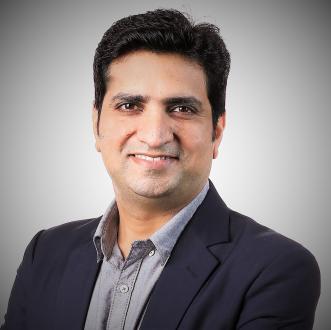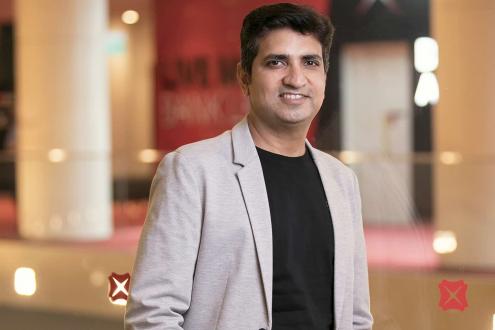DBS Technology & Transformation Expert on the Holistic Approach to Digitisation in Wealth Management

Jitendra Tekchandani of DBS Bank
Jul 26, 2022
Jitendra Tekchandani, Executive Director, Regional Customer Segment and Customer Science, Wealth Management at DBS Bank, is passionate about his mission at the bank. He firmly believes that marrying the right technologies and strategies can greatly benefit clients, and the banks that achieve such goals will then, quite naturally and organically, be the true leaders in their field. And very importantly, he knows that to achieve this, the RMs and advisors must also be empowered with strategies and technologies that allow them to give their best. Jitendra was one of our expert panellists at the Hubbis Digital Dialogue on June 2, which addressed the application of the latest digital solutions to the world of Asian wealth management as technology revolutionises the offerings and efficiencies of private wealth managers across the region. He delivered some very valuable insights on these topics and did so with great clarity and enthusiasm. We have selected and summarised some of his observations in this short report.
Everyone in the world of wealth management today agrees that the delivery of a relevant, personalised and realistic investment advisory and product suite is essential for success. The key topic of the virtual discussion on June 2 was how to transform and scale this offering amid continued growth of private wealth in the region, and as incumbents face up to the threats of big brand institutions at the forefront of digital transformation as well as new entrants who are agile, sometimes well-funded and often targeting various wealth management market niches in the region.
Digital solutions for today and tomorrow
The assembled panel of experts analysed where technology solutions can help banks and other players to improve their investment offerings, not only in terms of the product suite and platform, but also in the delivery of optimal RM-led communication, advisory and DPM.
They helped identify what the next suite of solutions might be, and debated whether technology investment is being properly targeted and executed. They also discussed how wealth management organisations in Asia could best adopt and assimilate these new technologies to enhance their investment propositions.
Connecting the online and offline world
The reality is that much time and money can be wasted by not taking the right approach. And as a digital leader, DBS is one of the establishments that others genuinely look to for an understanding of best-in-class strategies with which to best capture the immense potential in Asia’s wealth management landscape. From Jitendra’s perspective, he clearly believes that the first step to getting digitisation right is ensuring that it is deeply embedded in the bank’s DNA, and not simply regarded as a side project.
He told delegates how his particular mission at DBS centres on a platform called Client Connect, which is a proprietary platform designed and built in-house by DBS. Meant to empower the frontline to deliver optimal advisory and experiences for clients, it combines data analytics and AI/ML technologies to curate timely, relevant and personalised guidance for the frontline to then act on and deliver to their clients. The platform is designed to be scalable according to the client’s needs and is currently used in servicing all client segments, starting from retail, to the affluent, and even the wealthiest private bank clients.
“The philosophy behind Client Connect is that it is critical for banks to be able to deliver seamless online-offline customer journeys in today’s increasingly digital world. We need to provide a hybrid journey that marries the best of technology and human expertise,” he shared. “At DBS, we call this a ‘high-tech, smart-touch’ approach. And to achieve this, we need to continue to strengthen our digital channels, whilst also ensuring this is synergised with their offline experiences.”
He elaborated that this is especially so for HNW clients given the complexity of their needs – take for example the likes of estate and wealth planning, or certain sophisticated investments or solutions that simply cannot be done self-service via digital means.
“So, for the past couple of years, we have been trying to sync these two parts so that the journey is not disjointed,” he elucidated. “And to help us achieve this, we needed first to neatly synchronise the online and offline. This wasn’t an easy feat, but we were able to do so, and build Client Connect, thanks to DBS’ immense effort and investments over the past decade and more into enhancing our digital infrastructure across the front, middle and back end – be it frontline tooling, mobile banking, internet banking, personalisation, data, AI, or the like,” he told delegates.
Are you happy?
He also commented that DBS needs to solve whatever problems their frontline teams face and simplify the employee journey.
“This is key as we believe that once our employees are happy, our customers will be too. Accordingly, we need to make our employees smarter, specifically the RMs, and then deliver consistent service and advice to our customers.”
Jitendra shared that DBS also monitors closely how ‘happy’ or how ‘smart’ these developments are making the bank’s frontline.
“We’re very big on listening to the customer and in a similar way, we believe it’s key to listen to our employees as well,” he reported. “So we are bringing all our client-servicing philosophies and good practices to our frontline. We even run feedback sessions to understand what is working for them and what isn’t, and keep iterating from there. It’s a continuous process.”
Real-time feedback
“Through our chats with the frontline staff, we realised that a key problem they face was the lack of information – for example, their clients may be engaging the bank digitally for various services, but as the RMs could not easily see or know of all of these, they weren’t able to have a full and updated view of their clients’ needs. This means there’s a need to make it easy for the RMs to access such information, so that they can provide more meaningful support.”
The second problem that the frontline highlighted was about the timing of their calls and communication with clients. “Traditionally, they would rely on their skills and judgement to decide when to call which clients,” Jitendra reported. “But by using data and AI and paying attention to client preferences, we’re now able to help determine when’s best to engage a certain customer, which goes a long way in improving their overall satisfaction as well as outcomes.”
Creating a more personalised proposition
The third area of improvement is around hyper-personalisation. “One size does not fit all. We believe that the entire offering needs to be specially customised for each and every individual customer,” Jitendra explained. “And personalisation is not only about the engagements, products, or services; it’s also about location and timing, such as the ability to be cognisant of a customer’s lifecycle events, for example. All these dots need to be connected.”
Next-best conversations
He then turned his focus to a comment made by a fellow panellist on next best action for client-facing bankers. “This is where we're really using data and AI to define the ‘next best conversation’ for the RMs,” he reported. “We call it a next best conversation because the action follows the conversation. We look at their online behaviour, life events, demographics, and their risk profiles.”
On this relationship with money and risk, he explained that people with similar demographic and even financial characteristics might have very different views on money and risk. “Some are ready for risk, for example, to leverage more volatile assets, while others with the same sort of wealth may shy far away from any sort of risks. Some save, some spend. So, it's important to understand all this and curate the right approach and offerings for each customer accordingly.”
Working within the right context
Picking up on a comment from another panellist on the challenges facing client-facing bankers, Jitendra explained that an area of improvement is in the RM’s preparation for meeting or communicating with clients.
He said this often takes a lot of their time because, first, they have to gather the information about the customer, then they have to think about the trends, the CIO insights, and so forth. And for the conversations to then progress well, the RMs need to understand the client’s context. “And this is exactly why and where we are thinking about the employee journeys, and how to make it all simpler and better,” he stated.
Jitendra added that all interactions and actions need to be logged, so DBS and teams all learn as they go ahead. “We cannot expect RMs to write up all these engagements, so this is where leveraging and managing unstructured data into useful structured data is so important,” he elucidated.
The need for operational excellence
Furthermore, even if very good engagement is then achieved, Jitendra said the bank needs to also deliver operational excellency.
“If your fulfilment is taking too much time and is too difficult, this can impact the outcomes,” he cautioned. “In the world of digital, it isn’t enough to make things look beautiful, - the whole operational piece also needs to be seamless and excellent. In short, we need to reduce and simplify processes, smooth out the handoff from one department to another, and use the right technology and tools.”
Hopes and expectations
Jitendra then turned his attention to the anticipated technology advances that will further boost the proposition, and what he would like to see emerge.
“We need to continue improving our self-directed digital channels,” he reported. “This does not mean that we keep adding new functionalities; rather, it’s to make our functionalities even more personalised and meaningful.”
Today, every bank, perhaps even every app, uses push notifications to talk to the customer, but whether such communications are meaningful or timely for them remains unclear. “This is why we will continually monitor our nudges and notifications – to understand which nudge, or which notification works for people, and how it’s connected with the previous communications,” he commented.
Secondly, he said technology will come and go, so he prefers to talk not so much about what is coming next in terms of technology, but in terms of what the industry needs. “One key area is to improve self-directed activity, another is to sync online and offline journeys, the third is to make RM tools world-class and the employee journey more meaningful,” he reported.
Data, insights and relevance
He drew his observations to a close by mining down further into the value of data and analytics in helping to engender the right connectivity between RMs and clients. “Everybody has data, but technology helps us to connect all this data to come up with meaningful insights about the customer, which then sets the context for good conversations as mentioned earlier,” he said. “Understanding the client’s needs and context, and tying this back to what we can offer as a bank, results in a meaningful and relevant offering for the customer.”
Trust-centred wealth management
And that, he stated, also helps foster mutual trust between the institution and the client. “And once you have that trust, it makes for a long-lasting engagement and relationship,” he concluded.
The final part of the equation is the culture of the organisation. “Traditionally,” he explained, “the measurement of business has been revenue and profitability. But we also need to understand the drivers of the outcomes, then understand and adapt these to achieve better business – which centres on better outcomes for the customers, and better outcomes for the frontline. The whole wealth management journey is all about trust, expertise, relevance, and the outcomes. And technology can help us in all of these vital areas.”

Executive Director, Customer Science & Segment, Wealth Management at DBS Bank
More from Jitendra Tekchandani, DBS Bank
Latest Articles






